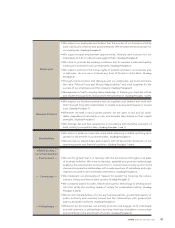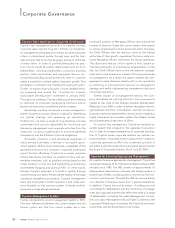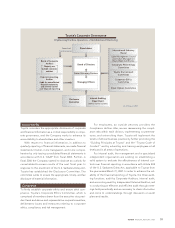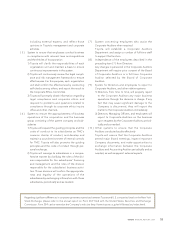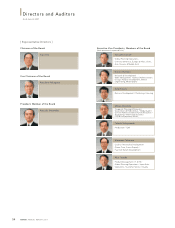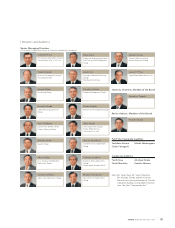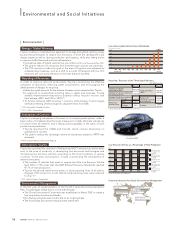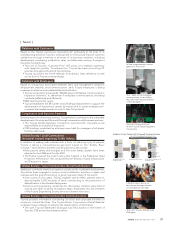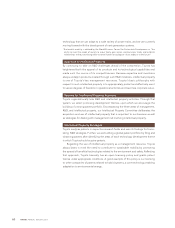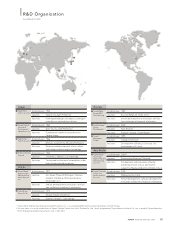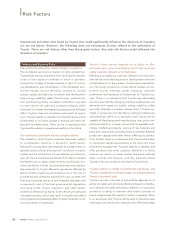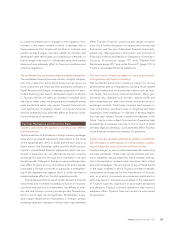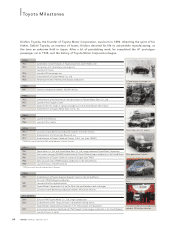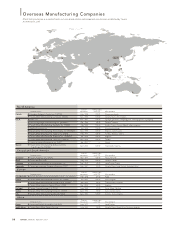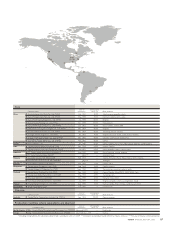Toyota 2007 Annual Report Download - page 61
Download and view the complete annual report
Please find page 61 of the 2007 Toyota annual report below. You can navigate through the pages in the report by either clicking on the pages listed below, or by using the keyword search tool below to find specific information within the annual report.
ANNUAL REPORT 2007 59
R&D Organization
In Japan, Toyota Central Research & Development Laboratories, Inc., mainly conducts
Toyota’s R&D activities. Also, Toyota Group companies, including Daihatsu Motor
Co., Ltd., Hino Motors, Ltd., Toyota Auto Body Co., Ltd., and Kanto Auto Works, Ltd.,
develop products in close collaboration with Toyota’s R&D. Further, Toyota is con-
structing a global development organization. We have established technical centers
in North America, Europe, Asia, and Oceania in order to build cars that cater accu-
rately to customer needs in respective regions. In addition to those centers, we have
also created design and motorsports R&D bases in respective regions.
Further, Toyota concluded an agreement on an operational tie-up with Isuzu
Motors Limited in November 2006. Focusing on diesel engines as an important envi-
ronmental technology, Toyota and Isuzu Motors will take full advantage of comple-
mentary management and technological resources to jointly undertake advance
development of next-generation small diesel engines.
Note: Please see the R&D Organization section on page 61 for further details.
R&D Activities
The overriding goal of Toyota’s technology and product development is to minimize
the negative aspects of cars, such as environmental burden and traffic accidents, while
maximizing the positive aspects, such as driving pleasure, comfort, and convenience.
At all times, we aim to open the way to a new automotive society through advanced
solutions that simultaneously meet the requirements of “incompatible” goals.
In the development of safety technology, Toyota continues to take initiatives to
develop technologies in the areas of active safety and passive safety as well as pre-
crash technologies linking these two areas. In recent years, the Company has con-
centrated technology development efforts on an integrated safety management
concept. Those efforts seek to ensure safety in all driving phases by integrating
safety systems that previously controlled different driving phases separately. For
example, we have further evolved our Vehicle Dynamics Integrated Management
(VDIM) system by adding functions that control steering and vehicle stability. At the
same time, we have achieved even better collision avoidance by integrating the
management of VDIM with Pre-crash Safety Systems, which use cameras and radars
to achieve recognition and assessment functions. Through such initiatives, we want
to continue radically evolving cars’ safety functions.
In the development of environmental technology, Toyota is stepping up mea-
sures that realize sustainable mobility* by heightening the convenience of automo-
biles while contributing to the preservation of the environment. One area of focus is
the development of power-train technologies, which lie at the heart of efforts to
improve vehicles’ environmental performance. In developing those measures, we
emphasize three broad themes: improving fuel efficiency to reduce CO2, preventing
atmospheric pollution through cleaner exhaust emissions, and adapting to energy
diversification. In putting into practice our strategy of providing the right vehicle for
the right place at the right time, we keep abreast of energy diversification trends and
provide countries and regions with the type of vehicles they need when they need
them. One of Toyota’s major initiatives, hybrid technology is a core environmental
Toyota Motor Engineering &
Manufacturing North America, Inc.
(Ann Arbor, Michigan, U.S.A.)
Toyota Motor Europe R&D/
Manufacturing (Brussels, Belgium)
Head Office Technical Center
(Toyota City, Aichi Prefecture, Japan)
R&D Facilities


